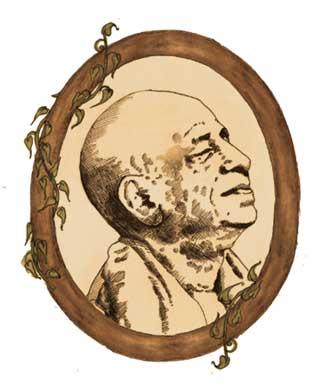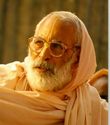

"Our only desire should be to take birth under the care of a Vaisnava. Fortunately we had the opportunity to be born of a Vaisnava father who took care of us very nicely. He prayed to Srimati Radharani that in the future we would become a servant of the eternal consort of Sri Krsna. Thus somehow or other we are now engaged in that service."
(Srila Prabhupada's purport to Sri Caitanya-caritamrta, Antya-lila, 1.24)
There is a difference between rupanuga [*Endnote 1] and raganuga [*Endnote 2]. Those who are eternally liberated associates serving Radha and Krsna in Vrndavana are called ragatmika, and such associates are described by Srila Rupa Gosvami in Sri Bhakti-rasamrta-sindhu and Sri Ujjvala-nilamani. In this world, those who want to serve like ragatmikas are called raganuga, because they are following the path of raga, or loving attachment. Raganuga devotees have transcendental greed for vraja-bhakti and are truly following the process to attain it.
Rupanuga-bhaktas are only those who follow the same manner and mood in which Sri Rupa-manjari serves Radha and Krsna. Although Sri Rupa-manjari serves both Radha and Krsna, she is more inclined towards Srimati Radhika - happy in the happiness of Srimati Radhika and suffering like Her when She suffers. Internally, in their constitutional forms, the rupanuga-bhaktas serve in the same mood as Sri Rupa-manjari, and externally they practice the same devotional activities as Rupa Gosvami.
Not all raganuga devotees are rupanuga. Sri Jayadeva Gosvami is raganuga but not rupanuga. Sri Bilvamangala Thakura is also truly raganuga, but not rupanuga. Sri Svarupa Damodara and Sri Raya Ramananda are not rupanuga. Although they are intimate associates of Srila Rupa Gosvami, they are not his followers. In Sri Krsna's pastimes they are Lalita devi and Visakha devi respectively. They are in a higher rank than the manjaris, so they are not rupanuga.
Lalita and Visakha and Yasoda-maiya are neither raganuga nor rupanuga. They are not anuga at all. Anuga means follower. In this connection, anuga refers to one who practices bhakti by following in the footsteps of Sri Krsna's eternal associates. Lalita, Visakha and Mother Yasoda are already eternal associates, and therefore they are ragatmika. [*Endnote 3].
Those who want to serve like ragatmikas are called sadhakas (practitioners) of raganuga. If one follows this path, inwardly meditating, How can I serve Lord Krsna like Mother Yasoda or Nanda Baba? he is raganuga, not rupanuga. Those who follow Srila Rupa Gosvami's Bhakti-rasamrta-sindhu under the guidance of the sakhas, like Subala, Sridama and all others like them, will also not be called rupanuga. They will be called raganuga.
Parama-pujyapada Srila Bhaktivedanta Swami Maharaja has come especially to give this rupanuga-bhakti, and what to speak of vaidhi-bhakti. He did not come only to give raganuga-bhakti. At that time, however, he could not give this to his general disciples because most of them were not at the stage to understand. Even now, although I am endeavoring with great effort to make you understand this subject matter, only a few are trying to understand.
When Srila Swami Maharaja went to America approximately twenty-five years ago, he could not openly preach this topic becuase there was practically no one qualified to understand it. The basic foundations of spiritual life needed to be established, and therefore he was mostly engage in 'cutting the jungles' of philosophical misconceptions. But he wanted to give this.
It cannot be true that he has only come to preach vaidhi-bhakti, because the entire disciplic succession of Gaudiya mission is rupanuga. Srila Nimbarkacarya sampradaya is also raganuga, but of Dvaraka. It is mixed with a conception of the Lord's opulence, following the moods of Satyabhama and Rukmini, and therefore it is not pure raganuga. Nimbaditya Acarya's followers are not like those of Srila Rupa Gosvami. Only the acaryas coming in the line of Sri Caitanya Mahaprabhu through Srila Rupa Gosvami are rupanuga.
So how is it possible that Srila Swami Maharaja could have come only to give vaidhi-bhakti? I have known Srila Swami Maharaja since 1946, and I never saw him in that way. I know personally that he has not come only to give vaidhi-bhakti. He came to preach rupanuga-bhakti. He has not come only to give vaidhi-bhakti.* [See Endnote 4] We will have to perform vaidhi-bhakti, of course, and by this, bhakti will manage everything. Bhakti is not only a quality she is not nirvisesa, impersonal. She is a person. Krsna is controlled by prema-bhakti. Krsna, and Srimati Radhika, and all Their associates, are controlled by bhakti. Bhakti can make Radha dance, Krsna dance, the gopis dance, and bhakti herself dance. She makes everyone dance.
[* Endnotes:
On Rupanuga:
1. It is not that Srila Bhaktivedanta Swami Prabhupada has discovered something new, and that we are "Prabhupadanugas". It is not that Rupa Gosvamis followers are Rupanuga Vaisnavas and Srila Prabhupadas followers are Prabhupadanuga. All our acaryas have told us to follow the Rupanuga Vaisnavas but who are Rupanuga?
Sri Caitanya Mahaprabhu first of all inspired all spiritual truths in Srila Rupa Gosvami's heart, as well as all knowledge of the Vedas, Upanisads and all other scriptures. Then, by the Lord´s mercy, Srila Rupa Gosvami knew His heart:
sri-caitanya-mano-'bhistamBy the mercy of Sri Caitanya Mahaprabhu, Srila Rupa Gosvami manifested, or wrote, so many books, such as Sri Bhakti-rasamrta-sindhu, Sri Ujjvala-nilamani and Sri Upadesamrta. He explained everything about Vraja-bhakti in Sri Ujjvala-nilamani and Sri Bhakti-rasamrta-sindhu. He wrote Sri Ujjvala-nilamani especially to give vraja-prema and vraja-bhakti. He explained in Bhakti-rasamtra-sindhu that bhakti can be experienced by five moods and five kinds of services; santa, dasya, sakhya, vatsalya and madhurya. Among them, three are prominent sakya, vatsalya and madhurya. The mood of the Vrajabasis is vraja-bhakti; especially, the mood of the gopis is madhurya-rasa in vraja-bhakti; and especially, the mood of Srimati Radhika is the highest emblem of vraja-bhakti.
sthapitam yena bhu-tale
svayam rupah kada mahyam
dadati sva-padantikam[When will Srila Rupa Gosvami Prabhupada, who has established within this material world the mission to fulfill the desire of Lord Caitanya, give me shelter under his lotus feet?"]
Srila Rupa Gosvami explained, "There are two processes of practical devotional service. One is regulative devotional service, and the other is spontaneous devotional service." (Caitanya-caritamrta Madhya-lila 22.108)] Those who follow the path of raganuga in any rasa other than manjari-bhava in madhurya-rasa are rupanuga, but not so much partly, very partly. In fact, it can also be said that they are not rupanuga. (Srila Narayana Maharajas lecture of May 18, 2004; Badger, California)]
2. Consequently we always request members of the International Society for Krishna Consciousness to publish as many books as possible and distribute them widely throughout the world. By thus following in the footsteps of Srila Rupa Gosvami, one can become a rupanuga devotee. (Purport Sri Caitanya-caritamrta Madhya-lila 19.132)
3. "We Gaudiya Vaisnavas are known as Rupanuga. Rupanuga means the followers of Rupa Gosvami. Why should we become followers of Rupa Gosvami? Because sri-caitanya-mano 'bhistam sthapitam yena bhu-tale. He wanted to establish the mission of Sri Caitanya Mahaprabhu." (Srila Prabhupada's Srimad-Bhagavatam (5.5.2) lecture: Hyderabad, April 13, 1975)
4. Rupa Gosvami and Sanatana Gosvami are the most exalted servitors of Srimati Radharani and Lord Sri Caitanya Mahaprabhu. Those who adhere to their service are known as rupanuga devotees. (Madya 8.246 purport.)
5. Unless you become rupanuga, you cannot understand the Gaudiya philosophy. (Srila Prabhupada's lecture in Vrndavana, Oct. 1972)
On Raganuga-bhakti:
1. One has to serve Krsna according to these regulative principles, but if one develops spontaneous love for Krsna as exhibited in the activities of those who live in Vrajabhumi, one attains the platform of raganuga-bhakti. One who has developed this spontaneous love is eligible for elevation to the platform enjoyed by the inhabitants of Vrajabhumi. In Vrajabhumi, there are no regulative principles set forth for Krsna's service. Rather, everything is carried out in spontaneous, natural love for Krsna." (Sri Caitanya-cartiamrta, Madya 8.221 purport)
2. "Devotional service in spontaneous love is vividly expressed and manifested by the inhabitants of Vrndavana. Devotional service that accords with their devotional service is called raganuga-bhakti, or devotional service following in the wake of spontaneous loving service." (Sri Caitanya-caritamrta, Madhya 22.154)]
On Ragatmika
1. "The original inhabitants of Vrndavana are attached to Krsna spontaneously in devotional service. Nothing can compare to such spontaneous devotional service, which is called ragatmika-bhakti. When a devotee follows in the footsteps of the devotees of Vrndavana, his devotional service is called raganuga-bhakti." (Sri Caitanya-caritamrta, Madhya 22.149)
2. "When one becomes attached to the Supreme Personality of Godhead, his natural inclination to love is fully absorbed in thoughts of the Lord. That is called transcendental attachment, and devotional service according to that attachment is called ragatmika, or spontaneous devotional service. (Madhya 22.149)
3. "Those who have not attained the platform of spontaneous attachment in devotional service render devotional service under the guidance of a bona fide spiritual master according to the regulative principles mentioned in the revealed scriptures. According to the revealed scriptures, this kind of devotional service is called vaidhi-bhakti. (Madhya 22.109)
Editorial advisors: Sripad Madhava Maharaja and Sripad Brajanatha dasa
Transcriber and typist: Vasanti dasi
Editor: Syamarani dasi
HTML: Bhutabhavana dasa
![[BVML Home Page]](../../grfx/bml_logo.gif)
